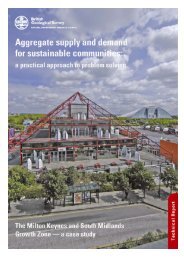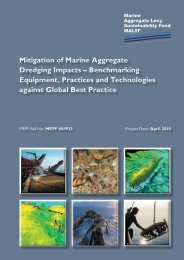creating environmental improvements through biodiversity
creating environmental improvements through biodiversity
creating environmental improvements through biodiversity
Create successful ePaper yourself
Turn your PDF publications into a flip-book with our unique Google optimized e-Paper software.
Sustainable Aggregates Creating Environmental Improvements <strong>through</strong> Biodiversity<br />
which has large areas of open water near to an RAF base. The preliminary results show that the technique is<br />
effective in detecting patterns in bird movements in relation to geographical (habitat) features.<br />
Impacts (Potential):<br />
Further analysis of these results may reveal useful relationships of bird movements with geographical features.<br />
This could be considered in the future design of minerals site restorations where bird strike is likely to be an<br />
issue, and in development of guidelines on the matter.<br />
Potential Expansion:<br />
The report states that additional analysis is needed to create a larger and more robust dataset from which to<br />
analyse bird behaviour<br />
It states that movements should be studied <strong>through</strong>out a year or over a number of years to allow for<br />
seasonal variations<br />
The technique could be applied more widely to study bird movements at other relevant sites, where funding<br />
is available. The report states that this would be advantageous as it would allow the findings to be applied to<br />
a wider range of situations across the UK.<br />
Dissemination:<br />
This report forms part of a larger study by CSL and RSPB (‘Developing policy and best practice in relation<br />
to restoration following minerals extraction – resolving conflicts with aviation’), which will inform policy and<br />
best practice guidance.<br />
GUIDELINES FOR THE CREATION OF BAP HABITATS AT MINERAL SITES<br />
IN WORCESTERSHIRE (DEFRA, WORCESTERSHIRE COUNTY COUNCIL)<br />
Project Type: Review, case studies, guidelines<br />
Site: Mineral sites in Worcestershire<br />
Project Aim: To assess the merits of future restoration plans in Worcestershire. To provide a source<br />
of reference for future restoration plans. To shortlist habitats that are most appropriate for given sites. To<br />
facilitate the industry’s role and commitment to achieving nature conservation objectives.<br />
Main Methods: Combination of best practice, assessment of a selection of past and present extraction<br />
sites in Worcestershire<br />
Output:<br />
Description of the Worcestershire BAP<br />
Discussion of restoration and aftercare of minerals sites, and the need to consider long-term management<br />
Discussion of the compatibility of nature conservation restoration with other end-uses<br />
Description of BAP habitats in the Worcestershire context<br />
Provision of key information on creation of these habitats at aggregate sites (with advice to seek skilled<br />
ecological guidance prior to <strong>creating</strong> them)<br />
Provision of references and further reading on these topics<br />
Discussion of natural regeneration at minerals sites and local sourcing of seeds species for planting<br />
Mention of vulnerable habitats close to proposed mineral sites that may be affected by extraction<br />
Mention of the habitats created during extraction processes<br />
Mentions landscape scale considerations and linking / expanding existing habitat fragments<br />
Explanation of NVC communities and description of those occurring in the county – tables showing<br />
considerations for each<br />
Description of ‘ecological natural areas’ where aggregate extraction is concentrated in the county (plus<br />
92

















